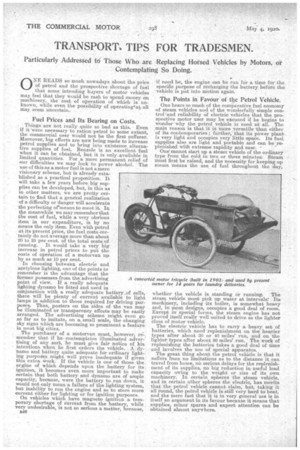TRANSPORT , . TIPS FOR TRADESMEN.
Page 22

If you've noticed an error in this article please click here to report it so we can fix it.
Particularly Addressed to Those Who are Replacing Horsed Vehicles by Motors, or Contemplating So Doing.
NE READS so much nowadays about the price of petrol and the prospective shortage of fuel
that some intending buyers of motor vehicles may. feel that they w.culd be rash to spend money on machinery, the cost. of operation of which is unknown, while even the possibility of operating'at, all may seem uncertain.
Fuel Prices and Its Bearing on Costs.
• Things are not really quite so bad as this. Even if it were necessary to ration petrol to some extent, the commercial user would not be the first sufferer. Moreover, big efforts are now being made to increase petrol supplies and to bring into existence alternative supplies of fuel. Benzole is an excellent 'fuel when it can be obtained, but it is onlyavailable in limited quantities. For a more permanent, relief of our difficulties we may look to power alcohol. The use of this as &motor fuel is not a mere visionary scheme, but is already established as a practical proposition. It will take a. few years before big sup plies can be developed., but, in this as ia other matters, we are pretty cer tain to find that a general realization of a difficulty or danger will accelerate the perfecting ormeans to meet it. In. the meanwhile we may remember that the cost of fuel, while a very obvious item in our expenditure, by no means the only item. Even with petrol at its present price, the fuel costs cer
tainly do not average more than about 20 to 25 per cent. of the total costa of running. It would take a very big increase in petrol prices to put the costs of operation of a motor-van up by as much as 10 per cent.
In choosing between electric and. acetylene lighting, one of the points to remember is the advantage that the former possesses from the advertising point of view. If a really adequate lighting dynamo be fitted and used in conjunction with a really adequate battery ,of there will• be plenty of current available to light lamps in addition to those required for driving purposes. Thus, posters on the sides of the van may be illuminated or transparency effects may be easily arranged. The advertising scheme might even go so far as to imitate, on a small scale, the changing sky signs which are becoming so prominent a feature in most big cities.
The purchaser of a motorvan must, however, re-, member that if he, contemplates illuminated advertising of any sort, he must give fair notice of his intentions when he first orders the vehicle. A dynamo and battery quite adequate for ordinary lighting purpoSes might well prove inadequate if given this extra work. If the vehicle is one of those the ergine of which depends upon the battery for its ignition, it becomes even more important to make certain that both battery and dynamo are of ample capacity, because, were the battery to run down, it would not only mean a failure of the lighting system, bat inability to run the engine and so to store more current either for lighting or for ignition purposes. On vehicles which have magneto ignition a temporary shortage of current from the battery, while very undesirable, is not so serious a matter, because, if need be, the engine can be run for a time forthe apecifie purpose of recharging the battery. before the vehicle is put into motion again.
The Points in FavOur of the Petrol Vehicle.
One hears so much of the comparative fuel economy of steam vehicles and of the wonderfully simple control!'and reliability Of electric vehicles that the prospective motor user may be excused if he begins to wonder why the petrol vehicle is used at all. The main reason is that it is more versatile -than either of its contemporaries ; further, that its power plant.. is very light and occupies very, little space. Its fuel supplies also are light a,nd portable and can be „replenished with extreme rapidity and ease.
One' cannot start up a steam vehicle of the ordinary type from the cold in two or three minutes: Steam must first be raised, and the necessity for keeping up steam means the use, of fuel throughout the day,
whether the vehicle is standing or running. The steam vehicle must pick up water at intervals. Its machinery, including -its boiler, is somewhat heavy and, in mast designs, occupies a good deal of room. Except inspecial forms, the steam engine has not proved itself really well suited to drive as the lighter class of motor vehicle.
The electric vehicle has to carry a heavy set of batteries, which need replenishment on the heavier types after about 20 or 40 miles' run, and on the lighter types after about 80 miles' run. The work of replenishing the batteries takes a good deal of time and involves the use of special apparatus.
The great thing about the petrol vehicle is that it suffers from no limitatiens as to the distance it can travel from home, nb serious delays for the replenishment of its supplies, no big reduction in useful load capacity owing to the weight or size of its own machinery. In certain spheres the steam vehicle, and in certain other spheres the electric, has merits that the petrol vehicle cannot claim, but, taking it all found, the petrol vehicle is still very hard to beat, and the mere fact that 'it is in very general use is in itself an argument in its favour because it means that supplies, minor spares and expert attention can be obtained almoist anywhere.




























